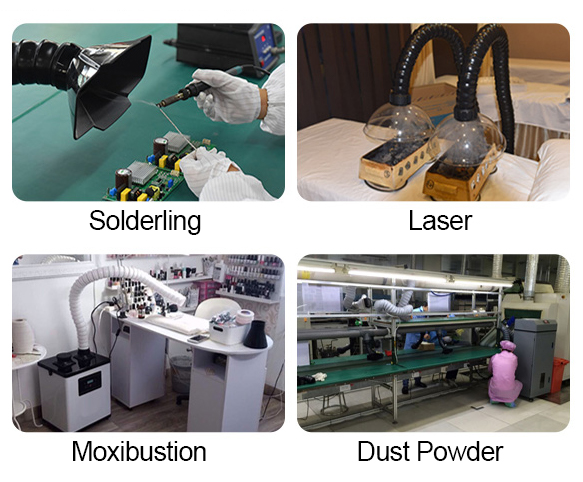What is a Fume Extractor Used for?
A fume extractor is a device used to remove and filter airborne pollutants, gases, vapors, and particulate matter generated during various industrial processes, laboratory work, or other activities that produce harmful fumes. As an important device, fume extractor is widely used in various fields and places. Its function is not only to eliminate fumes and odors but also to protect people's health and create a comfortable working environment. Next, this article will explore the diverse applications of fume extractors and their significance in different settings.
Applications
-
Industrial Workplaces: Industrial workplaces are one of the main application areas of smoke extractors. Industries such as manufacturing, welding, metal processing, and chemical production often generate a significant amount of pollutants and hazardous fumes. The portable fume extractors are commonly used in these settings, especially at localized workstations. Welding stations, for example, release harmful welding fumes that contain metal oxides, gases, and particulates. By positioning portable fume extractors with flexible hoses or arms near these sources, pollutants are captured at their origin, preventing their dispersion into the wider workspace.
-
Laboratories and Research Facilities: Laboratories and research facilities deal with a diverse range of chemicals, gases, and substances that can pose health risks if not properly managed. Fume extractors equipped with activated carbon filters are essential in these environments. These filters effectively adsorb volatile organic compounds (VOCs) and odorous substances, ensuring that the air remains free from harmful chemicals. In addition, laboratories dealing with biological agents and pathogens require specialized fume extractors to prevent the release of contaminants into the environment.
-
Healthcare Facilities: In healthcare facilities such as hospitals and clinics, maintaining clean and sterile environments is paramount. Airborne pathogens and contaminants can compromise patient health and safety. Fume extractors equipped with HEPA filters play a critical role in these settings by capturing airborne bacteria, viruses, and particulates. These filters are capable of trapping particles as small as 0.3 micrometers with high efficiency, thus preventing the spread of infections and improving overall indoor air quality.

-
Commercial Spaces: Commercial spaces, including offices, retail stores, and restaurants, benefit from fume purifier systems to enhance indoor air quality and provide a pleasant environment for occupants and customers. While these environments might not generate as many pollutants as industrial settings, factors such as building materials, cleaning agents, and occupant activities can contribute to indoor air pollution. Fume extractors with HEPA filters and activated carbon filters help remove allergens, dust, and odors, creating a healthier and more comfortable space.
-
Residential Homes: In residential settings, smoke extractors are utilized to address indoor air pollutants originating from cooking, cleaning, and household activities. Kitchen smoke purifiers, often integrated into range hoods, are designed to capture cooking fumes, grease, and odors, preventing them from accumulating in the living spaces. Additionally, portable air purifiers equipped with HEPA filters and activated carbon filters are popular choices for bedrooms and living rooms, ensuring that family members breathe clean and allergen-free air.
-
Educational Institutions: Fume evacuator devices are used in educational institutions to promote a safe and healthy environment. Fume evacuators are commonly installed in science labs, workshops, and art studios to remove harmful fumes and smoke generated during experiments, technical activities, and art processes. Fume extractors help protect students and staff from exposure to pollutants and maintain clean air quality.
-
Art and Creative Spaces: Art studios, workshops, and creative spaces can produce a variety of airborne pollutants, including paint fumes, solvents, and dust particles. Air scrubbers with a combination of filters, including activated carbon and HEPA filters, are beneficial in these settings. They effectively capture volatile compounds and particulates, protecting the health of artists and creators while maintaining the integrity of their work environment.
-
Clean Rooms and Electronics Manufacturing: Industries that require strict control over airborne particles, such as electronics manufacturing and semiconductor production, rely on clean room environments. Fume extractors equipped with HEPA filters are essential to maintain the required cleanliness levels by capturing microscopic particles that could compromise the manufacturing process. These smoke extractors ensure that the final products meet quality standards and function reliably.
-
Laser Cutting and Engraving:Laser machines produce fumes and particulates when cutting or engraving materials, and fume abatement systems are used to capture and filter these emissions to protect operators and maintain air quality.
-
Printing: Fume extractor systems are commonly installed in printing machines and post-printing areas to extract and filter out volatile organic compounds (VOC) and other pollutants. They also contribute to the quality of prints by reducing the risk of contamination and ensuring clean air during the printing process.
In short, the fume extractor has a wide range of applications, whether it is home, commercial, industrial, laboratory, medical environment or other places, any place that needs to eliminate smoke, fumes and odors can use smoke exhaust. Fume extractor devices play an important role in improving the quality of life, the safety of the working environment, and maintaining air quality standards.

